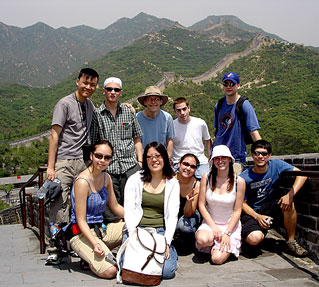Campus News
Students Learn by Touring the Silk Road
by Greta Petry (December 9, 2005)
 |
| UAlbany students on the Great Wall. |
East Asian Studies professors Jim Hargett and Mark Blum led a three-week study tour of China in May and June. They accompanied 10 University at Albany undergraduates who had taken Hargett and Blum's "The Silk Road" seminar class in the spring.
"With funding provided by a generous grant from the Freeman Foundation, we took these students on a study tour of ancient Silk Road sites in China," Hargett said. The students were selected in a competitive application process.
According to the Web site for the Silk Road Project, the phrase refers to "a vast network of trade routes" which "linked the people and traditions of Asia with those of Europe. These historic routes served as a major conduit for the transport of knowledge, information, and material goods between East and West and resulted in the first global exchange of scientific and cultural traditions."
Hargett said, "The key places we visited included the city of Xi'an (where the Silk Road began in China), the Dunhuang caves in Gansu province, and several other cave complexes in Xinjiang province. Many of these caves have Buddhist art (wall paintings), some of which date back to the fifth century."
Brandon Bjerke, a senior from Flemington, N.J., said, "This trip was an extraordinary opportunity and a wonderful experience culturally, historically, and personally. Though about half, perhaps more, of the students had been to China before, none of us had seen anything like we did in western China. Most of the people are Muslim and live in or around a desert environment, and unfortunately, most are trapped in abject poverty. Yet they were friendly, generous, and always interested in speaking with us, selling something, or at least giving a wave."
Sacha Mercier, a second-semester junior who moved to Huntington, N.Y., from France when she was 12, said, "I was immediately mesmerized by the mysterious, beautiful, and powerful Asian thought, culture, and history." Mercier noted, "For a night, we had the grace of staying in a little Uighur village (a Central Asian people) that surrounded a Buddhist cave complex at Kyzil. Sharing space with these people was one of the best experiences of my life. They showed us such kindness and shared with us their bread and their smiles and that night invited us (to join them) to dance with them the traditional Uighur dance ... They allowed us into their homes when we couldn't even speak the same language."
Bjerke noted, "We students were ecstatic to be there and to delve into these remote cultures, and I was affected in a way I can only hope to be again. This was certainly a side of China I had never seen before and realistically knew very little about, and the ancient artwork we saw in the caves of Dunhuang, Kyzil, and the other sites was simply amazing. Most visitors who do see these caves, however, do not have the opportunity to hear descriptions and analyses of the paintings from a world-renowned expert on Buddhism like Professor Blum. And though it only lasted for a few minutes, participating in a meditation in front of a 70 to 80-foot-long statue of the Buddha constructed over a thousand years ago was beyond words."
Blum said, "Buddhist cave art in Central Asia is invaluable visual evidence of how Buddhist truths were understood 1,500 years ago, as well as how Buddhist aesthetics evolved in the rich multicultural arena that characterized the Silk Road, mixing artistic traditions not only from India and China, but also Afghanistan, Persia, Kazakhstan, Tibet, and East Turkestan. The enormity of the story of Buddhism's appeal to so many different nationalities can only be appreciated by going to the sites themselves and marvelling at their achievements, and we all felt this deeply."
The students rode camels to desert oases, climbed part of the way up a famous Buddhist mountain, trekked through desert mountains in search of caves, socialized with Uighur people (who are the multiracial majority of the population of Xinjiang province), and found other adventures along the way.
"This trip was a marvelous encounter with a culture within a culture that simply does not get enough attention. Western China has a multitude of incredible experiences to offer, and I cannot thank enough those who allowed me to participate in this experience," Bjerke said.
After returning to Albany, each student
was required to submit a research paper on
an approved topic related to the Silk Road.
Previous tours led by East Asian Studies faculty include China's Ancient Capitals (2002), Living
Buddhism in Japan (2003), and Tibet (2004).
